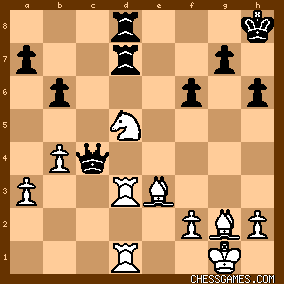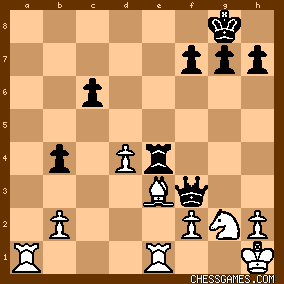Sep-24-12
 | | An Englishman: Good Evening: I'm not certain that White is better after 20...Qf5. Q & P vs. 3 minors is a very slight material edge; what's more, White has a lot of isoslated pawns, weak light squares, and a less-than-wonderful Be3. However, Black's total lack of minor pieces will complicate any attempt to exploit those weak pawns. So I would *guess* that the position is about equal. What sayeth the monsters of silicon? |
|
Sep-24-12
 | | Phony Benoni: <An Englishman> Good Morning. I would suspect that is a position which a computer would play better than it would evaluate. |
|
| Sep-24-12 | | xthred: Very entertaining. Would love to see it played out. |
|
| Sep-24-12 | | The Last Straw: <Phony Benoni><An Englishman>I'm on the good night side because I live in California. |
|
| Sep-24-12 | | SEVEN: In the final potition black can;t avoid 52.Bb7
I quess thats the reason for the resignation. |
|
| Sep-24-12 | | sofouuk: <An Englishman><So I would *guess* that the position is about equal. What sayeth the monsters of silicon?>you are probably right that the position is within the drawing margin, rybka says slight (-0.2ish) advantage black. i wouldn't underestimate white's pieces (including the Be3) but the real problem is the h2-pawn - if it falls black will start to get very interested in promoting his own. best first move is 21 d5 (what bad bishop?) Rad8 and then white apparently chooses between 22 dxc6, Rd4 and Bf1. in the game, of course, black quickly went wrong with the 25 Qc2/26 Qc4 maneuver |
|
| Sep-24-12 | | sofouuk: on second thoughts, the most logical way for white to go might be 21 Bf1! Rad8 22 Bg2 and how can black make progress? h6 23 d5! cxd5 24 Rd4, double the rooks and take the pawn back whenever you want even then, though, guess it might be possible for white to lose it after the rooks come off. easier to threaten with a queen than coordinate three minors on an open board, is the point |
|
Sep-24-12
 | | AylerKupp: <An Englishman> Coincidentally I just finished reading the chapter on Queen vs. Three Minor Pieces from "Understanding Chess Middlegames" by John Nunn. Here is what Nunn has to say about it: "In a large majority of middlegame positions, three minor pieces are worth more than a queen. In an endgame the queen starts to assert its power and is often at least a match for the three pieces." "In the middlegame, the pieces are at their best in a direct attack on the enemy king. In other situations, the pieces prefer a quiet position in which they can manouvre to target enemy pawns or other weaknesses. If the side with the queen has no active counterplay, the pieces can often pick off enemy pawns one by one." So how would you categorize the position after 20...Qf5?

click for larger viewBlack has no weaknesses and an attack against the Black king doesn't seem to hold out much chances of success. And, of course, he has an extra pawn. In contrast, White has 4 pawn islands and 3 of its pawns are isolated, so I would think that in an endgame Black should prevail, in spite of White's 2 bishops. At d=26 Houdini 1.5a indicates that Black stands somewhat better, evaluating the resulting position at [-0.36] after 21.Bf1 Rad8 22.Bg2 h6 23.d5 cxd5 24.Nxd5 Kh8 25.Rd2 b6 26.Red1 f6 27.Rd4 Rd7 28.b4 Red8 29.a3 Qc2 30.R4d3 Qc4.

click for larger viewWhite has eliminated one of his pawn weaknesses, the IQP, and has improved the position of his pieces. It looks like a standoff in the d-file; White can't move his knight without the undesirable exchange of both rooks but then again, why would he want to move the knight from such a great post? Black on the other hand, can't attack the knight any further. So Black wouldn't seem to be able to make much progress on the d-file. What else can he do? One possibility is ...a5 to try to open up an additional file on the q-side for his rooks. If one of the pawns is exchanged the remaining isolated pawn may be weak enough for Black to pick off. But White can defend any weak q-side pawn with more pieces than Black can use to attack it, so in the absence of any tactical tricks this doesn't seem to hold out much hope for an advantage. The other possibility that comes to mind is a pawn storm on the k-side where Black has a pawn advantage. But this will open up the position in front of Black's king, perhaps not such a good idea with White's 2 bishops. And the advanced pawns might become weak, enabling White to pick them off one by one. After all, White can throw more pieces to the attack than Black has to defend. So ....? I think I'll let Houdini run for a while longer. Much longer. |
|
Sep-24-12
 | | AylerKupp: <Phony Benoni> You may be right, this might be a position which a computer would play better than it would evaluate. So I set up a 2-round, mini-tournament between Houdini 1.5a and Rybka 4.1, alternating colors, 2 hours for the entire game and see who might win in practice. In the trial 5-min game to test the set-up, Rybka (White) managed to set up a fortress that I didn't see how Houdini (Black) could penetrate. But Rybka got into time trouble (as usual), and even though the game probably should have ended in a draw per the 50-move rule, once Rybka couldn't search more than 10 plies/move (and often less) its play deteriorated drastically (also as usual) so Houdini got the win. I'll post the results of the tournament when it's done. The game score for the 5-min blitz game starting with White's 21st move, in case you're curious: [Event "Steflitsch vs. Benz 20...Qf5"]
[Date "2012.09.24"]
[White "Rybka 4.1 w32"]
[Black "Houdini_15a_w32"]
[Result "0-1"]
[WhiteType "program"]
[BlackType "program"]
21.d5 Rad8 22.dxc6 bxc6 23.Bf1 Qe6 24.Rc1 Rd6 25.Bg2
f5 26.b3 Qf6 27.Ne2 g5 28.h4 h6 29.Bc5 Rde6 30.hxg5 hxg5 31.Kf1 f4
32.Bh3 Re4 33.f3 Qh8 34.Bg4 Qh1+ 35.Bg1 Re3 36.Kf2 Kf7 37.Rcd1 a5 38.
Rd2 R8e5 39.Rc1 c5 40.Rcc2 Kf8 41.Rd8+ Ke7 42.Rd1 Ke8 43.Rdd2 Re7 44.
Rc1 Kf7 45.Ra1 Qh8 46.Rb1 a4 47.Kf1 Qh1 48.Kf2 Qh4+ 49.Kf1 Qh7 50.Rbb2 Qh1 51.Kf2 axb3 52.axb3 Kf6 53.Rd6+ Kg7 54.Rdd2 Kg6 55.Rbc2 Kf6
56.Rb2 R7e6 57.Rbc2 Re8 58.Rd6+ Kg7 59.Rdd2 R8e5 60.Rb2 Kf6 61.Rd6+
Kf7 62.Rd7+ Ke8 63.Rdd2 Re7 64.Rd1 Qh4+ 65.Kf1 Qh8 66.Rdd2 Qh1 67.Kf2
Kf7 68.Rb1 Kg6 69.Rc1 R7e5 70.Rb1 Kh6 71.Rbb2 Re8 72.Rbc2 R3e5 73.Rc1
Kg6 74.Rd6+ Kg7 75.Rd7+ Kf8 76.Rd2 R8e7 77.Rcc2 Kg7 78.Rb2 Kh7 79.Ra2
Kg8 80.Rd8+ Kg7 81.Rdd2 Kf6 82.Rd6+ Kf7 83.Rdd2 Re8 84.Bd7 Rb8 85.Ra7
Re7 86.Ra3 c4 87.Bc6 g4 88.Nxf4 g3+ 89.Kf1 cxb3 90.Ra1 Qh6 91.Bd5+
Ke8 92.Rd4 b2 93.Rb1 Rc8 94.Bc4 Rxc4 95.Rxc4 Qa6 96.Ne2 g2+ 97.Kf2
Qxc4 98.Rxb2 Qd3 99.Bh2 Kf7 100.Ra2 Qb1 101.Nc1 g1=Q+ 102.Kxg1 Qxc1+
103.Kg2 Kg8 104.Bg3 Rg7 105.Kh2 Qh6+ 106.Kg1 Qg6 107.Kh1 Qxg3 108.Ra8+ White resigns 0-1 |
|
| Sep-24-12 | | kevin86: It looked like black just gave up. |
|
Sep-24-12
 | | AylerKupp: <kevin86> I didn't record the times each engine took for its moves but towards the end Rybka only had seconds left in its clock and milliseconds for each move. The screen was going quite fast but I think that Rybka was only searching about 5-6 plies so it played quite poorly. Heck, if I restricted Rybka to only search 5-6 plies deep I could beat it every time. And, BTW, Rybka (White) won the first game of the 2-hour tournament. Here is the game score starting from White's 21st move with some notes. Worth playing over to see the nice coordination of the White pieces towards the end. [Event "Steflitsch vs. Benz 20...Qf5"]
[Date "2012.09.24"]
[Round "1"]
[White "Rybka 4.1 w32"]
[Black "Houdini_15a_w32"]
[Result "1-0"]

click for larger view21.Bf1 h6 22.d5 Rad8 23.Bg2 cxd5 24.Rd4 Qc2 25.Re2 Qg6 26.Red2 Kh8 27.h3 f5 28.Nxd5 Qf7 29.R2d3 Kh7 30.Bd2 b5 31.Bb4 h5 32.Bf3 Qg6+ 33.Kf1 Qf7 34.Rh4 g6 35.Kg2 Kh6 36.Bd2+ Kg7 37.Bg5 Rd6 38.Rhd4 <Red8> 39.Bxd8 Rxd8 40.Rb3 a6 41.Rc3 Kh6 42.Rc6 Qb7 43.Re6 Qc8 44.Rb6 Qc1 45.Rxa6 Qg5+ 46.Kf1 <Qc1+> 47.Rd1 Qxb2 48.h4 b4 49.Kg2 Rd7 50.<Rxg6+> Kxg6 51.Nf4+ Kh6 52.Rxd7 Qxa2 53.Rd6+ Kh7 54.Bxh5 Qa8+ 55. Kg3 Qc8 56.Bg6+ Kh8 57.Rd5 b3 58.Bxf5 Qb8 59.Kg4 b2 60.Kg5 Kg8 61.Rd1 Qb7 62.h5 Qe7+ 63.Kg4 Qf6 64.Bg6 Kg7 65.h6+ <Kh8 >66.Rd7 Kg8 ♗lack resigns <1-0>

click for larger view<38.Red8> This was an interesting move by Houdini. Who says that engines are materialistic? Black sacrifices the exchange in order to eliminate White's DSB and alleviate the dark square holes around its king. Alas, it didn't turn out well. <46...Qc1+> Was Houdini hoping for a draw by repetition? Obviously, Rybka declines it. <50.Rxg6+> And now all of Black's k-side pawns fall. As Nunn said, "in the middlegame, the pieces are at their best in a direct attack against the enemy king." Including, as you'll see, the king! Rybka must have read Nunn's book. :-) <65....Kh8> 65...Kxh6 fails against 67.Rh1+ and 68.Nh5+. The point of the pawn "sac". <1-0> A nicely played attack by Rybka. What a difference additional time on its clock makes! |
|
Sep-24-12
 | | AylerKupp: Well, after 3 more search plies Houdini's eval of the resulting position is slightly lower, [-0.31], d=29 after 21.Kh1 b5 22.Bf1 b4 23.Na4 Rad8 24.Nc5 Rd6 25.Bg2 a5 26.Nd3 Rg6 27.a3 Re4 28.axb4 axb4 29.Nf4 <Rxg2> 30.Nxg2 Qf3 31.<Ra1>.

click for larger view<29...Rxg2> Houdini must be in an exchange sacrifice mood today. <31.Ra1> Houdini still thinks that Black has the slightly better position, in spite of its exchange sacrifice for Black, and I would guess that it would play 31...h5 next. And with White's light square weaknesses around its king, I wouldn't disagree. In fact, starting after 31...h5 Houdini evaluates the resulting position as a win for Black at [-3.74], d=24, after 32.Bd2 Rg4 33.Re8+ Kh7 34.Rg1 h4 35.Re3 Qxf2 36.Bc1 Rxd4 37.h3 Rc4 38.b3 Rc3 39.Rxc3 bxc3 40.Nf4 c2 41.b4 Qf3+ 42.Kh2 f6 43.Ng6 Qe2+ 44.Rg2 Qe1 45.Rg1 Qxb4 46.Kh1 c5 47.Kh2 Qd4 48.Rg2 Qd6+

click for larger viewIf Black manages to exchange the queen for R+N then the mass of Black pawns should be able to overwhelm the bishop. But here is the score of the second game of the tournament with Houdini (White) vs. Rybka (Black) from this position:

click for larger view[Event "Steflitsch vs. Benz 20...Qf5"]
[Date "2012.09.24"]
[Round "2"]
[White "Houdini_15a_w32"]
[Black "Rybka 4.1 w32"]
[Result "1/2-1/2"]
21.Bf1 Rad8 22.d5 cxd5 23.Rd4 Kh8 24.Red1 a6 25.Bg2 h6 26.Be4 Qg4+ 27.Bg2 Qg6 28.Nxd5 Qf5 29.a4 <b5> 30.axb5 axb5 31.h3 Qc2 32.R4d2 Qf5 33.b4 Rd6 34.Rd4 <Re5> 35.Bf4 Rdxd5 36.Bxd5 Rxd5 37.Rxd5 <Qxf4> 38.Rxb5 Qf3 39.Rd4 Qxh3 40.Rb8+ Kh7 41.Rb7 Qf3 42.Rdd7 Qg4+ 43.Kf1 Qc4+ 44.Kg2 Qe4+ 45.Kh2 Qf4+ 46.Kg1 Qg5+ 47.Kf1 Qc1+ 48.Kg2 Qg5+ 49.Kf3 Qf5+ 50.Kg3 Qg6+ 51.Kh2 Qh5+ 52.Kg2 Qg4+ 53.Kh2 Qh5+ 54.Kg1 Qg5+ 55.Kh2 Qh5+ 3-fold repetition 1/2-1/2

click for larger view<29...b5> IMO eliminating one of the q-side pawns helps White and not Black. <34...Re5> Rybka is in an exchange sacrifice mood also. Apparently this is probably the only way that Black can hope to make progress. <37...Qxf4> With the elimination of all the minor pieces the resulting R+R vs. Q+P endgame is a likely draw, even if the pawn structure becomes unbalanced. White can't avoid the queen checks. So, it may be that Black has a definite advantage but it's hard to convert it to a win OTB. Oh well, that was an interesting exercise. |
|
Sep-26-12
 | | An Englishman: Good Evening: <AylerKupp>, that *was* an interesting exercise! Thanks for taking the time. |
|
|
|
|





